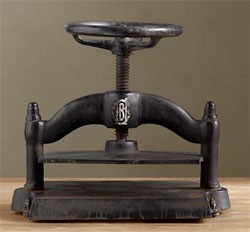 Recently on the book arts listserv, someone posted a link to the “bookbinding press” to the left — sold at Restoration Hardware as “a faithful reproduction of a century-old bookbinder’s press, used to keep even pressure on books as they dried” and “hefty enough to double as a bookend, and useful for pressing forget-me-nots between pages as well.” Someone responded that this was “copy press” not a “book press,” which started a conversation about the difference between the two.
Recently on the book arts listserv, someone posted a link to the “bookbinding press” to the left — sold at Restoration Hardware as “a faithful reproduction of a century-old bookbinder’s press, used to keep even pressure on books as they dried” and “hefty enough to double as a bookend, and useful for pressing forget-me-nots between pages as well.” Someone responded that this was “copy press” not a “book press,” which started a conversation about the difference between the two.
My understanding is the main difference between a copy press and a book press is the amount of daylight between the platen and the base. My press has only 3-1/2″ daylight which is fine for a single book. Book presses have
at least 12″ of space so they can accommodate more than one book in the press.
David Amstell piped in
It would seem that there is a difference between a Copy Press and a Bookbinder’s Press… The central screw of the true bookbinder’s press has a thread with a considerably lower slope. This means that when the press is tightened up, the wheel or T-bar can be given an extra distance of tightening, thus providing extra pressure to the book. On the other hand, the platen of many copy presses, which usually have a higher screw slope, bounce back slightly from the full tightening, thus giving an inefficient pressing…The manufacturers of some of the modern bookbinding presses, it would appear, have realised this principle of the low-angled screw. Consequently, their presses are very efficient to use.
But what exactly is a “copy press?” Several people on the listserv mentioned an out-of-print book “Before Photocopying: The Art And History Of Mechanical Copying 1780-1938” by Barbara J. Rhodes and William W. Streeter (Hardcover – May 1999), but didn’t explain. So I looked online and found 2 things: Thomas Jefferson’s design for a portable copying press was first built in London in 1786, see a picture here and more about it here. And in this nice post about Richard Bell’s research into the history of a copy press he got from his father, he clears up the difference with this:
In an article published in The Office magazine about Victorian desktop publishing, Darryl Rherr writes:
“Desktop Publishing’s first century began in 1856, when British chemist William Perkins discovered the first synthetic dye, aniline purple. This dye pointed the way to a wide range of new inks, including ‘copying ink’ used in the first practical method of reproducing business documents.
An original written with copying ink was placed against a moistened sheet of tissue, the two were pressed together in a massive iron press, and a copy would appear on the tissue. Since the copy was backwards, the tissue had to be held up to the light to be read. The copy press became a fixture in every Victorian office. Today, they are sold in antique shops as ‘book presses,’ their true function long forgotten.”

my question is, can you actually use this as a book press? it says it’s a ‘reproduction’ and could be used as a bookend… so is it just decoration, or is it functional??? (cuz i waaaaant it!)
This is a delightful piece of research. Thanks for posting it.
Angela, if you see one, snap it up. I have a copy press, old quarto size and I use it as a book press though it does only take one book at a time. I can give it quite a nip so it works well. The Archives of the Australian Museum contains ‘letter books’ of copies of pages of correspondence from the earliest years of the Museum, reproduced as described by Darryl Rherr, above. I have no doubt that such ‘letter books’ are in the Archives of institutions all over the world and there must have been hundreds of pressses dumped over the years.
thank you for some very good information, and I must say, quite entertaining as well…so much to learn…thanks!!
If you are in London, you can buy the genuine antique article at Falkiner’s paper shop over by Central St. Martin’s. People bring them in and leave them on consignment, or they used to.
At 55 lbs, the Restoration Hardware looks to be heavy enough to be usable, at least for relief printing.
I have a press, and the strange thing is, I found it on a pile of trash waiting to be burned on a rural property. Judging by the discussion above, I’m guessing it has a low screw slope because it does not bounce back from tightening. It has about 3 inches of daylight.
There are only traces of paint left. It can turn an aluminum beverage can into a coin. That’s a popular trick with children at science shows and such. I once closed it tight, then put a torque wrench on the top nut, then tightened until the nut moved, at about 30 foot/pounds.
.
I RECENTLY FOUND AN OLD LETTER PRESS WITH ABOUT 4 INCHES OF TRAVEL.
IT HAS THE CAST IRON BALL TYPE HANDLE AND IS FASTENED ON THE BOTTOM WITH SQUARE HEAD BOLTS (GUESSING). I FIRST THOUGHT IT TO BE A BOOK PRESS BUT YOUR ARTICLE CHANGED MY MIND. I HAVE FOUND NO CASTING MARKS BYT WHEN TURNED OVER YOU CAN TELL IT IS CAST.
IT’S A BIT HEAVY FOR A DOOR STOP OR TRIVET TO SET AROUND, I GUESS 100+ POUNDS.
ANY SUGGESTIONS REGARDING A GOOD DISPOSITION FOR THIS?